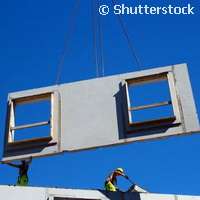Building blocks to safer buildings

Precast or ready-made building structures offer a number of advantages when compared to more traditional construction techniques, in terms of time and cost savings. However, the vulnerability of joints and connections between assembled precast elements is widely recognised as a potential safety issue, especially in earthquake-prone areas.
The EU-funded SAFECAST project (Performance of innovative mechanical connections in precast buildings structures under seismic conditions) has set out to develop new procedures and guidelines for designing precast structure joints and connections that can stand up to seismic forces.
Precast building structures are produced by casting concrete in a reusable mould or form which is then cured in a controlled environment, transported to the construction site and lifted into place. The process saves time and costs less than conventional on-site casting of concrete.
Led by Italy's Assobeton - Associazione Nationale Industrie Manufatti Cementizi, the project takes an innovative, unified approach, considering all basic performance requirements, including durability, deformability limits and energy dissipation.
Partners say their consortium represents a unique combination of countries, including, Italy, Greece, Germany, Portugal, Slovenia, Spain and Turkey. For all of the partner countries, seismic activity is a fundamental consideration in the construction sector, and all are countries where concrete is the main construction material.
One of the key outcomes of the project has been the new publication 'Design Guidelines for Connections of Precast Structures under Seismic Actions'.This important document covers a wide range of mechanical joining techniques, all of which were studied in depth, both experimentally and numerically.
The guidelines are aimed at designers of buildings using precast structures, especially in situations where specific norms or mandatory provisions do not yet exist.
By combining new knowledge acquired during the project with existing state-of-the-art information, SAFECAST has delivered a broad set of guidelines covering an almost exhaustive list of connection types.
One notable exception is the use of cladding elements. In the construction field, cladding is the overlapping of one material or element over another, to form a weather-tight seal. Project partners have cited this as a potential subject for further research.
Taken together, the results of the project promise improved competitiveness for European precasting in construction. Within the sector, the new guidelines represent a means to achieve real improvements in the quality of new buildings, with better reliability and safety performance in the event of an earthquake.
More information: Project factsheet cordis.europa.eu/projects/rcn/90245_en.html
Provided by CORDIS




















